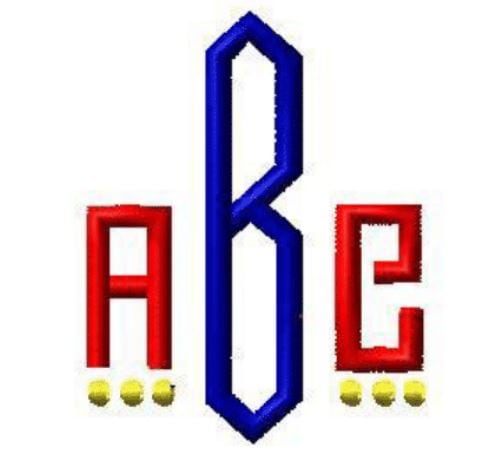
by The Embroidery Coach | | Embroidery Education
Here are 7 tips that will help you embroider designs on caps with ease and save you a lot of unnecessary frustration. Trying to get high-quality embroidery designs on caps can be a real challenge when you are new to embroidery but with a little practice and experimenting, you can overcome many challenges.
- For best results always start your design from the bottom up and from the center out. For better registration always finish one section of the design before going onto the next if at all possible.
- Your embroidery design for a standard cap should not be more than 2.10 inches High and if you are working on a low profile cap it usually cannot be more than 2 inches high. I try to stay within the 2-inch high category for all of my cap designs. Very often your customer will want a repeat order, but if they decide to change the type of cap for their new order you may have issues if the original design does not fit on the new cap.
Sometimes 2 inches is too high for a design if you have more than 1 line of straight lettering or if you have a design that has a long line of small straight lettering on the bottom. This can be a real problem. Your bottom line of lettering may pull up in the center of the cap.
- Make sure that the bottom of the design is at least one-half inch up from the seam where the cap front and the brim are sewn together. If you are working on a stiff cap front your letters may distort if you are sewing too close to the bottom of the cap. A lot of this depends on how the cap is made and how stiff it is at the very bottom of the front where it attaches to the brim. When you are hooping your cap, you must make sure that your cap facing is really tight into the lip of the cap framing device. If this does not work you have to either shorten your design to compensate or distort your lettering in the opposite direction. Sometimes just shortening the height of the design and moving it up slightly on the cap front will take care of the problem.
- If you are using an embroidery design for a cap that has been created for a left chest, it is not always possible without editing the design to make it embroider properly on the cap. If you have lettering on the bottom of the cap you will have better results if you edit your design so that this lettering will stitch out first. I have found that this works best. Make sure that your lettering is set up to stitch center out. If your lettering is not stitching center out, you will need to re-sequence the lettering.
- Always use cap backing when you are hooping your caps, regardless of how heavy or stiff your cap is. This also will help to produce a higher quality embroidery design on your cap. A 3 oz. tearaway cap backing is the best choice.
- If you are working with a stiff cap such as a FlexFit cap; I have found that steam pressing the cap first softens up the backing and flattens out the top part of the cap. This makes the cap sit closer and flatter against the needle plate and helps to embroider designs on caps a lot easier. This is especially important when you are embroidering designs on youth sized caps. They are smaller and it is harder to get them flat against the needle plate.
- Walk your machine when you first startup. By that I mean when you press the start button, keep your finger right on it and do not let up. This will allow the machine to stitch one stitch at a time and it will walk over that really thick part of the seam. When you just hit the start button in a normal fashion the machine is going at its fast speed. This causes the needle to deflect when it is trying to sew through those thick areas and will break. I am sure that you have seen this. If you walk the machine first, it will start very slow and you will avoid this from happening and this will help you to embroider designs on caps with ease.
I hope that these tips will help you embroider designs on caps with ease and make working with caps more pleasant than it has been in the past for you. Until you learn how to embroider designs on caps with ease, it can be very frustrating. Caps are a real money maker; they can be one of your biggest money makers, so it is to your benefit to learn how to embroider designs on caps with ease.

by The Embroidery Coach | | Embroidery Business Marketing
People work with businesses and professionals they trust. Building customer trust and loyalty in your embroidery business is an ongoing process. Here are 9 tips for building customer trust and loyalty with both old and new customers.
- Keep your agreements with your customers
If you promise delivery on a particular day, make sure to deliver when it was promised. Even something as small as the time you have scheduled an appointment is an agreement. Each time you break a promise to a customer, you break the trust.
- Create realistic customer expectations
Make sure the customer understands exactly what you will do for him or her and what is included in your service and what is not. What will create extra charges? How and when will you be billing the customer? Living up to the expectations you create helps to build trust with your customers.
- Help customers to understand the process and strategy for their order
If your customer understands how you and your business works and what the process of their order is, the customer can then know what to expect and when to expect it. Trust comes when the customer feels confident and comfortable with the plan and the strategy.
- Never over promise
It is tempting to promise whatever the customer wants to hear without looking at your schedule or asking if it is doable. When you do not deliver on your promise this causes broken agreements and broken trust.
- Carefully explain the customer’s role
When a customer is clear on what his or her role is then he or she gets clear on what progress can be made without their involvement. Getting really clear on what the customer needs to do to move his or her order forward, helps you work as a team and builds trust.
- Discuss potential problems that can happen
Nothing disturbs the trust of a customer more than when something unexpected happens. Guard against something negative happening as a surprise by discussing the potential pitfalls with the customer.
- Review the work order in detail
Any decisions that the customer is going to have to make should be discussed in detail. Relationships and trust are built over a long period of time but it can be broken easily. An unexpected issue that is a surprise to the customer that he or she was not expecting can break that trust quickly.
- Avoid making the customer feel stupid
No one likes to feel stupid. If customers feel that you think they are stupid they will no longer entrust you with their ideas or work. Customers who don’t feel valued by you may stop trusting you. No one sets out to make a customer feel stupid, but it could be an attitude, an inadvertent comment, or a look that gives the customer that impression. Be aware of your inner thoughts. They show up without your noticing. Be very careful with your language.
- Don’t allow interruptions when you are meeting with a customer.
It gives them the feeling that they are not important to you and you really do not want their business. Everyone needs to feel special no matter how large or small their order is. This can ruin the good will and trust that you had with them.
Building relationships and customer trust with both your customers and prospects helps you to build loyalty. Loyalty is something that is very uncommon in the embroidery business anymore but it is not impossible to get. When your customers feel that they are valued and you give them excellent customer service, they will become loyal!

by The Embroidery Coach | | Embroidery Tip
Always give your customer a completed embroidery design sew out sample to get their OK and have them sign off on their design. Creating embroidery design sew out samples is a very important step in your embroidery production process. You need to be able to show your customer a completed sample of how his embroidery will look before you actually embroider the design onto the customers finished garments.
I have discovered that most embroiderers create the embroidery design sew out samples on squares of backing fabric and give this to the customer for their approval. You really do not know what the actual design will look like on the finished products. The settings for the various types of fabrics need to be adjustment correctly for the best results on that fabric.
Having the exact same fabric is not always possible but there are fabrics that work as great substitutes. A t-shirt fabric works for a jersey knit placket shirt, the backside of a sweatshirt is a good substitute for a light weight fleece fabric, and an old worn out sheet is good replacement for a dress shirt or a handkerchief. If you use your imagination you can come up with a lot of close matches that will definitely work when you are creating your embroidery design sew out samples.
A great source for these type of fabrics are old garments that your family has discarded. I cut up various sized squares from old or unwanted garments and store them in plastic boxed that I have labeled: T-shirt fabric, Sweatshirt fabric, Wind shirt fabric, Terry cloth, Dress shirt fabric, and Heavy woven fabrics. When it is time for a new sew out sample these fabric squares come in very handy.
Another good source I found for inexpensive garments was at Goodwill or The Salvation Army stores. I needed some leather for a sew out sample and did not have any on hand. I found a jacket at the Goodwill store that had the lining ripped out of it. It was not selling so I was able to pick it up for $5.00. I have created a lot of sew outs from the one jacket.
You also want to choose a color of fabric that is closest to what the customer will be using. If this is not possible use a light color or neutral fabric for garments that will be a light color and a dark colored fabric for garments that will be a dark color. Create your embroidery design sew out sample in the correct colors that your customer will be using.
Giving your customer a completed embroidery design sew out sample on the correct type of cloth and in the correct colors shows him or her exactly how the embroidery will appear on the finished garments and it instills within them a level of confidence that you as a professional know exactly what you are doing.
Click Here to sign up for more embroidery tips! You will be sent a new embroidery tip each week!0
Joyce Jagger
The Embroidery Coach
by The Embroidery Coach | | Embroidery Business Management
Keep A Close Eye On Your Inventory Costs
Keeping close track of your inventory and supplies is a must when you are trying to control your supplies inventory costs in your embroidery business. Keeping a minimum on hand of all of your basic embroidery supplies is very important. You do not want to run out of a supply when you are in the middle of a job. Keeping a running inventory record is a must.
Planning ahead so that you are not ordering for overnight delivery is one of the ways to hold down shipping costs. Ordering in quantities, if at all possible, will reduce the costs of both the supplies and the shipping. Early payment discounts also helps to reduce the cost.
In a small shop the extra supplies can be stored in the actual work area. In a larger shop they must be stored in a separate Supply Storage area that is strictly for supplies or inventory. This will remove the extra clutter and keep the production and prep area more organized and cleaner.
Have One Person In Charge Of Inventory
Make sure that you have one person in charge of your inventory. When supplies are removed from the supply storage area, they must be accounted for so that they can be replaced before they are actually needed. Keeping a running log is very important in order to have this information at your fingertips at all times and it deters others from picking up supplies when they are not authorized to do so, controlling employee theft. In some areas this is a constant problem and one that is hard to pinpoint.
You as a business owner must do everything that you can to prevent losses to your business, and employee theft of supplies is an area that can be prevented. It is up to you to control supplies inventory costs in your embroidery business make sure that employee theft does not happen.

by The Embroidery Coach | | Embroidery Business Marketing
I want to congratulate Howard Potter! He is a very successful student of mine! Howard started with me about 12 years ago when he purchased his first embroidery machine. I worked with him when he was working out of his home with a single head Tajima and the Tajima by Pulse Embroidery software! He has since gone on to purchasing 2 more machines, digital equipment, screen printing equipment and much more. Howard now has his own building with a beautiful showroom and very well organized workrooms for each of the different types of applications that he offers.
He is very young man with a wife and 2 children. He and his wife Amanda have worked very hard in this business, turn out top quality work and have taken their business from zero to almost 2 million dollars in this short period of time.
I trained his main graphic artist, to digitize their designs and have since trained several more digitizers as the business has grown. They have worked very hard at producing high quality embroidery designs and on time delivery.
You can visit his website MasterYourImage .
Congratulations Howard, keep up the great work!!
Joyce Jagger,|
The Embroidery Coach




